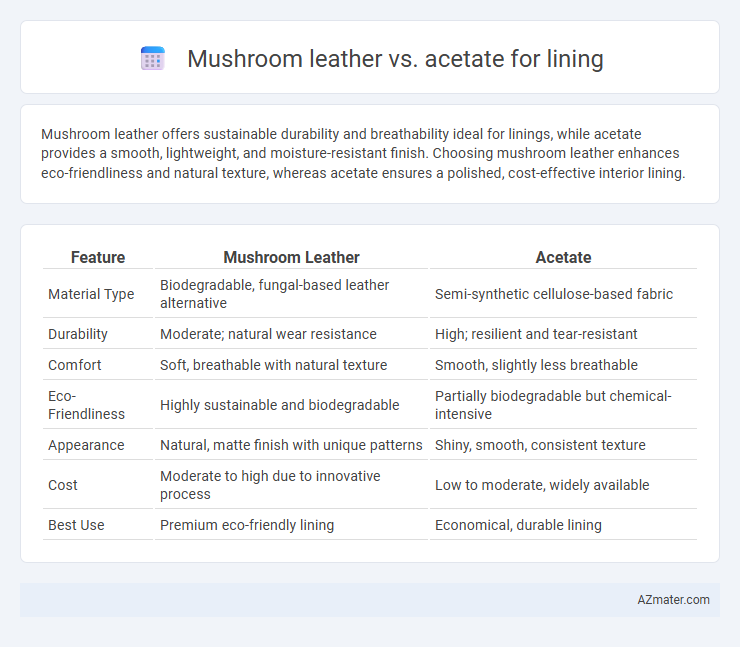Mushroom leather offers sustainable durability and breathability ideal for linings, while acetate provides a smooth, lightweight, and moisture-resistant finish. Choosing mushroom leather enhances eco-friendliness and natural texture, whereas acetate ensures a polished, cost-effective interior lining.
Table of Comparison
| Feature | Mushroom Leather | Acetate |
|---|---|---|
| Material Type | Biodegradable, fungal-based leather alternative | Semi-synthetic cellulose-based fabric |
| Durability | Moderate; natural wear resistance | High; resilient and tear-resistant |
| Comfort | Soft, breathable with natural texture | Smooth, slightly less breathable |
| Eco-Friendliness | Highly sustainable and biodegradable | Partially biodegradable but chemical-intensive |
| Appearance | Natural, matte finish with unique patterns | Shiny, smooth, consistent texture |
| Cost | Moderate to high due to innovative process | Low to moderate, widely available |
| Best Use | Premium eco-friendly lining | Economical, durable lining |
Introduction to Sustainable Lining Materials
Mushroom leather, derived from mycelium, offers a biodegradable and eco-friendly alternative to traditional linings, providing durability and a unique texture without the environmental impact of animal leather. Acetate, a plant-based cellulose fiber, is commonly used for lining due to its smooth finish, breathability, and lower carbon footprint compared to synthetic materials. Both materials contribute to sustainable fashion by reducing reliance on petroleum-based textiles and promoting renewable resources in garment construction.
What is Mushroom Leather?
Mushroom leather is an innovative, sustainable material made from mycelium, the root structure of mushrooms, offering an eco-friendly alternative to traditional animal leather. It is breathable, biodegradable, and has a natural resistance to moisture, making it ideal for lining high-quality garments and accessories. Compared to acetate, which is a synthetic fiber often used for linings but less environmentally friendly, mushroom leather provides enhanced durability and a unique texture while reducing ecological impact.
Understanding Acetate as a Lining Fabric
Acetate as a lining fabric offers a smooth, silky texture that enhances garment comfort and drape, making it a popular choice in fashion linings. Compared to mushroom leather, acetate is lightweight, breathable, and possesses a shiny finish that adds a luxurious feel to the interior of jackets and coats. Its affordability and ease of dyeing allow designers to achieve a wide range of colors and patterns, optimizing the aesthetic appeal of lined garments.
Environmental Impact: Mushroom Leather vs Acetate
Mushroom leather is a sustainable alternative made from mycelium, consuming less water and producing fewer carbon emissions compared to traditional acetate, which is derived from cellulose but often involves chemical-intensive processes. The biodegradability of mushroom leather significantly reduces landfill waste, whereas acetate, despite being plant-based, can take longer to decompose and may contribute to microplastic pollution when broken down. Choosing mushroom leather for lining materials aligns with eco-friendly practices by minimizing environmental footprints through renewable resources and lower toxicity levels.
Durability and Longevity Comparison
Mushroom leather offers superior durability and longevity compared to acetate, with its natural fibers providing enhanced resistance to wear and tear over time. Acetate lining, while smooth and lightweight, tends to degrade faster due to its synthetic composition, showing signs of fraying and loss of structural integrity with extended use. The bio-based properties of mushroom leather contribute to its sustained performance, making it a more resilient choice for linings subject to frequent friction and stress.
Comfort and Breathability Factors
Mushroom leather offers superior breathability and natural moisture-wicking properties, enhancing comfort in footwear linings compared to acetate. The porous structure of mushroom leather allows better air circulation, reducing heat buildup and preventing odor accumulation, while acetate tends to trap heat and moisture. This makes mushroom leather an ideal choice for linings where long-lasting comfort and breathability are essential.
Aesthetic Qualities and Texture Differences
Mushroom leather offers a unique, natural texture with subtle grain patterns and a matte finish, enhancing the overall aesthetic with an organic, eco-friendly appeal. Acetate for lining provides a smooth, glossy surface with a sleek and polished look, contributing to a refined and luxurious interior feel. The tactile experience of mushroom leather is more textured and earthy, while acetate delivers a silky, cool touch ideal for stable and breathable linings.
Cost and Accessibility of Both Materials
Mushroom leather, derived from mycelium, offers a sustainable lining option but tends to be more expensive due to limited production scalability and niche availability. Acetate, a plant-based cellulose fiber, is more widely accessible and cost-effective, making it a popular choice for lining in fashion and upholstery industries. The higher cost of mushroom leather reflects its innovative eco-friendly appeal, while acetate provides practicality through affordability and ease of sourcing.
Popular Applications in Fashion and Accessories
Mushroom leather, known for its sustainable and eco-friendly properties, is increasingly popular in high-end fashion accessories such as handbags, wallets, and watch straps due to its durability and unique texture. Acetate, derived from plant cellulose, is widely used in lining luxury eyewear, handbags, and shoes, appreciated for its smooth finish and breathability. Both materials emphasize sustainable fashion trends, with mushroom leather offering a biodegradable alternative and acetate providing a lightweight, hypoallergenic lining option.
Which Lining Material is Better: Final Considerations
Mushroom leather offers superior sustainability and biodegradability compared to acetate, making it an eco-friendly choice for lining materials. Acetate provides excellent breathability and moisture-wicking properties, enhancing comfort but lacks the natural durability of mushroom leather. For final considerations, mushroom leather excels in environmental impact and durability, while acetate is preferred for lightweight, breathable linings depending on application needs.

Infographic: Mushroom leather vs Acetate for Lining
 azmater.com
azmater.com